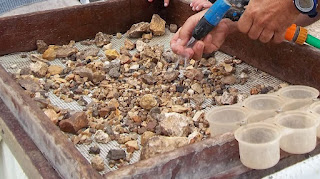Yesterday morning I spent a pleasant hour participating in the Temple Mount Sifting Project. This, the largest crowdsourced archaeological event in the world, is a trawl of some 400 truckloads of rubble that were removed from Jerusalem's Temple Mount in 1999 and dumped in the Kidron valley.
Some 9,000 tons of excavations have been reclaimed from the Kidron valley and, since 2004, volunteers have been slowly sifting through them in search of evidence of the Temple Mount's long and varied history. Many hundreds of thousands of items have been unearthed so far: coins, pottery, glass, metal artefacts, stone items of non-local origin, bones and tesserae (small cubes of ceramic or other material, used in the manufacture of mosaics).
The items found so far extend back as far as the era of the First Temple, reflecting Jewish, Islamic and Christian cultures.
Trying to find them is no easy matter for volunteers, and even experienced sifters can find it hard to identify what they have found, which is why many of the finds are sent to specialist laboratories for forensic examination. Pairs of volunteers are given a small bucket-load of what looks like mud, which they sift through by hand. Fragments of each "find" may be tiny and, unless they are sprayed with water, quite unrecognisable.
What does any of this have to do with Pirkei Avot, you may be wondering? A great deal, I believe. In mishnah 4:3 Ben Azzai teaches:
"Do not be scornful of any person and do not be dismissive of any thing, since there is no person who does not have his hour and no thing that does not have its place".
